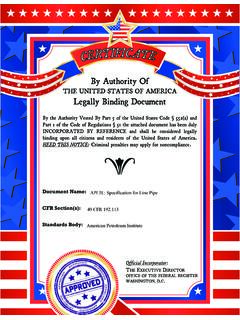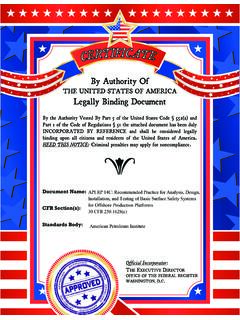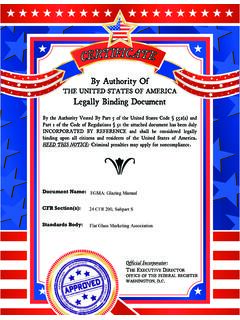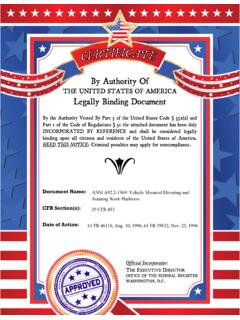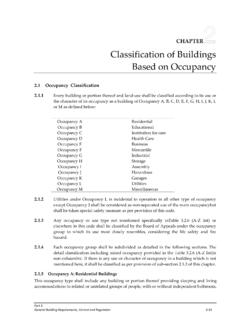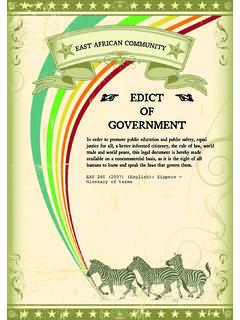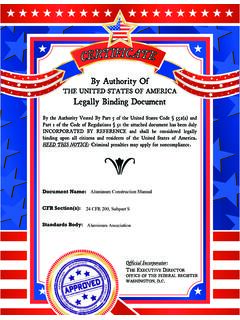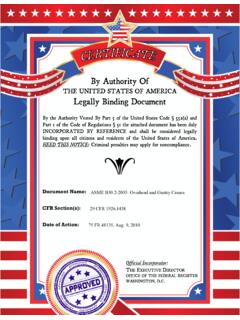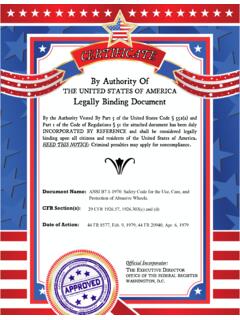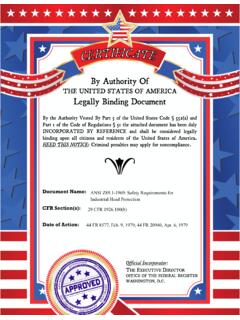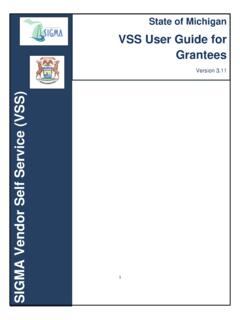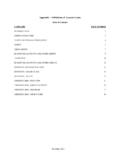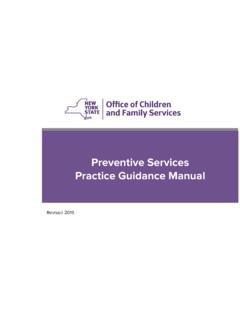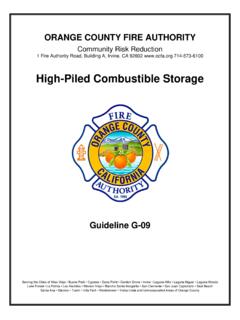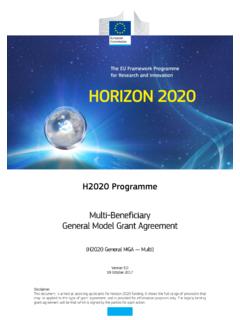Transcription of By Authority Of - Public.Resource.Org
1 By Authority OfTHE UNITED STATES OF AMERICAL egally Binding DocumentBy the Authority Vested By Part 5 of the United States Code 552(a) and Part 1 of the Code of Regulations 51 the attached document has been duly INCORPORATED BY REFERENCE and shall be considered legally binding upon all citizens and residents of the United States of America. HEED THIS NOTICE: Criminal penalties may apply for noncompliance. Official Incorporator:THE EXECUTIVE DIRECTOROFFICE OF THE FEDERAL REGISTERWASHINGTON, Name: CFR Section(s): Standards Body: eCGA (OBSOLETE) CLEANING EQUIPMENT FOR OXYGEN SERVICE THIRD EDITION COMPRESSED GAS ASSOCIATION, INC. 4221 Walney Road, 5th Floor Chantilly, VA 20151 Phone: 703-788-2700 Fax: 703-961.
2 1831 E-mail: PAGE ii _____ C=O=M"-P.:..:.R=ES=S=E= ;G=A'-"S:::..:..;A=s.:::.sO::;..C:::..:I .:..:; :..; ::;O.:..;N .. , :.:.,.IN:..;::c",-. _____ CGA PLEASE NOTE: The information contained in this document was obtained from sources believed to be reliable and is based on technical information and experience currently available from members of the Compressed Gas Association, Inc. and others. However, the Association or its members, jointly or severally, make no guarantee of the results and assume no liability or responsibility in connection with the information or suggestions herein contained. Moreover, it should not be assumed that every acceptable commodity grade, test or safety procedure or method, precaution, equipment or device is contained within, or that abnormal or unusual circumstances may not warrant or suggest further requirements or additional procedure.
3 This document is subject to periodic review and users are cautioned to obtain the latest edition. Comments and suggestions are invited from all users for consideration by the Association in connection with such review; any such comments or suggestions will be fully reviewed by the Association after giving the party, upon request, a reasonable opportunity to be heard. This document should not be confused with federal, state, provincial, or municipal specifications or regulations, insurance requirements or national safety codes. While the Association recommends reference to or use of this document by government agencies and others, this document is purely voluntary and not binding. THIRD EDITION: 1985 COPYRIGHT if) 1985 BY THE COMPRESSED GAS ASSOCIATION, INCORPORATED 1235 JEFFERSON DAVIS HIGHWAY.
4 ARLINGTON, VA 22202 Printed in CGA G-4. 1-1985 _____ --'C=:..O::;,; :..:.;P:..;, ;":E=S=S=ED=--=G;.:.,,A= :..,A.;,;;s= ;;;, :;;,C:.:-IA:..:..T=1O;.:,.; ! .:.:.,IN=C;.:.". _____ PAGE iii Contents Page Scope .. 1 2 Objectives .. 1 3 Planning requirements .. 1 Supervision .. 1 Selecting procedures .. 2 4 Precleaning .. 2 5 Steam or hot water cleaning .. 3 Materials .. 3 Steam cleaning .. 3 Hot water cleaning .. 3 Removal of cleaning agents .. 3 6 Caustic cleaning .. 3 Materials .. 4 Caustic cleaning procedures .. 4 Rinsing .. 4 Drying .. 5 7 Acid cleaning .. 5 Selection of cleaning agent .. 5 Equipment .. 5 Cleaning procedure .. 5 Rinsing .. 5 Drying .. 6 8 Solvent washing (including ultrasonic cleaning).
5 6 Solvent washing .. 6 Ultrasonic cleaning .. 6 Materials .. 6 Washing equipment.. 6 Control of solvent cleanness .. 6 Removal of solvents .. 8 9 Vapor degreasing .. 8 Equipment .. 8 Materials for vapor degreasing .. 8 Vapor degreasing procedure .. 9 10 Mechanical cleaning .. 9 Blast cleaning .. 9 Wire brushing or grinding .. 9 Tumbling .. 9 Swabbing, vacuuming .. 9 Blowing and purging .. 10 11 Inspection .. 10 Approval of quality control procedures and standards .. 10 Inspection procedures .. 10 12 Packaging and labeling .. 12 Protection from recontamination .. 12 Labeling .. 12 PAGE iV _____ C=o=M:.:..:..:..PR~E=S=S=E= ::G:;.:..A=S:..!.. :..::s=s=O~.
6 :..IA.:..:.T.:..:::1O:.,:..N:. ' .:..:.IN.:..:::C:.,:.. _____ CGA 13 Personnel safety .. 12 Instructions and supervision .. 12 Dangerous chemicals .. 12 Protective equipment .. 13 Proper ventilation .. 13 Special situations .. 13 14 References .. 14 List of Illustrations Table Table 1-Chemical and physical properties of cleaning solvents .. 7 CGA G-4. 1-1985 _____ ..::::C;..::o:..:..:M.:..:.. :..R~E=SS=E=D::..::::G"_'A= :..A=s:.:::s=O=C.:..:..IA~ :..::IO:..:..N:.L,..:.:.1 N.;.::C::..:.. _____ PAGE 1 1 Scope The cleaning methods described in this pamphlet are intended for cleaning equipment used in the production, storage, distribution, and use of liquid and gaseous oxygen. Examples of such equipment (illustrative of the primary intent of this publication) are: stationary storage tanks, cargo tanks, and tank cars; pressure vessels such as heat exchangers and rectification columns; and associated piping, valves, and instrumentation.
7 The cleaning methods, however, are not limited to the above equipment and with proper consideration or modifica-tion may be utilized in cleaning other oxygen service equipment such as cylinders, cylinder valves, regulators, welding torches, pipelines, compressors and pumps. NOTE: CGA C-10, Recommended Procedures for Changes of Gas Service for Compressed Gas Cylinders, [1]1 includes the conversion of cylinders to oxygen service. Where the requirements for this conversion differ from the recommendations of CGA , the recommendations of CGA C-1 a should take precedence. 2 Objectives Oxygen equipment and systems, including all components and parts thereof, must be adequately cleaned to remove harmful contamination prior to the introduction of oxygen.
8 Harmful contamination would include both organic and inorganic materials such as oils, greases, paper, fiber, rags, wood pieces, coal dust, solvents, weld slag, rust, sand, and dirt, which if not removed, could cause a combustion reaction in an oxygen atmosphere or result in an unacceptable product purity. This publication presents methods for cleaning oxygen service equipment. When properly used, these cleaning methods and subsequent inspections will result in the degree of cleanness required for the safe operation of oxygen service equipment and the necessary product purity required in CGA , Commodity Specification for Oxygen. [2] Suggested levels of contamination and ways of determining if a component or system is suffi-ciently clean to be used in oxygen service are given along with procedures for keeping such equipment clean before being placed in service.
9 Cleaning a component or system for oxygen service involves the removal of combustible contaminants includ-ing the surface residue from manufacturing, hot work, and assembly operations, as well as the removal of all cleaning agents and the prevention of recontamination before final assembly, installation, and use. These cleaning agents and contaminants include solvents, acids, alkalies, water, moisture, corrosion products, non-compatible thread lubricants, filings, dirt, scale, slag, weld splatter, organic material (such as oil, grease, crayon, and paint), lint, and other foreign materials. The removal of injurious contaminants can be accomplished by cleaning all parts and maintaining this condition during construction, by completely cleaning the system after construction, or by a combination of the two.
10 3 Planning requirements Supervision An individual skilled in the techniques required for oxygen service cleaning shall be responsible for monitoring the cleaning operation and determining if a component or system is clean so that it can function safely in an oxygen environment. Where piping systems with multiple branches are involved, it is of paramount importance that the cleaning procedures be well established, suitably integrated with the sequence of construction opera-1 NOTE: References in this document are shown by bracketed numbers and are listed in the order of appearance. See Sec-tion 14, References. PAGE 2. _____ C=o;..:,:M"-PR:..:.;E=s=s=E;.:::D~G:::;. :.:S:::;,.;A.
